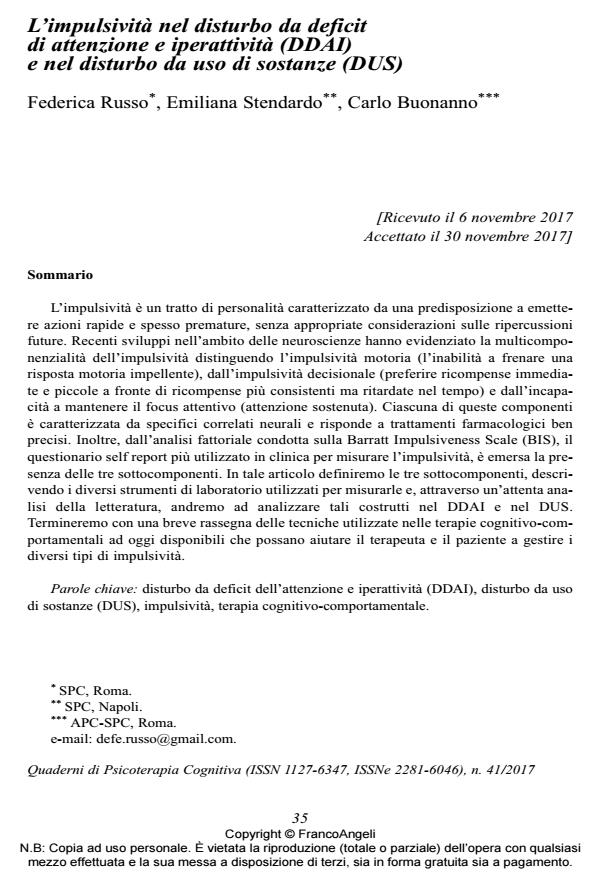L’impulsività nel disturbo da deficit di attenzione e iperattività (DDAI) e nel disturbo da uso di sostanze (DUS)
Titolo Rivista QUADERNI DI PSICOTERAPIA COGNITIVA
Autori/Curatori Federica Russo, Emiliana Stendardo, Carlo Buonanno
Anno di pubblicazione 2017 Fascicolo 2017/41
Lingua Italiano Numero pagine 17 P. 35-51 Dimensione file 120 KB
DOI 10.3280/QPC2017-041003
Il DOI è il codice a barre della proprietà intellettuale: per saperne di più
clicca qui
Qui sotto puoi vedere in anteprima la prima pagina di questo articolo.
Se questo articolo ti interessa, lo puoi acquistare (e scaricare in formato pdf) seguendo le facili indicazioni per acquistare il download credit. Acquista Download Credits per scaricare questo Articolo in formato PDF

FrancoAngeli è membro della Publishers International Linking Association, Inc (PILA)associazione indipendente e non profit per facilitare (attraverso i servizi tecnologici implementati da CrossRef.org) l’accesso degli studiosi ai contenuti digitali nelle pubblicazioni professionali e scientifiche
L’impulsività è un tratto di personalità caratterizzato da una predisposizione a emettere azioni rapide e spesso premature, senza appropriate considerazioni sulle ripercussioni future. Recenti sviluppi nell’ambito delle neuroscienze hanno evidenziato la multicomponenzialità dell’impulsività distinguendo l’impulsività motoria (l’inabilità a frenare una risposta motoria impellente), dall’impulsività decisionale (preferire ricompense immedia- te e piccole a fronte di ricompense più consistenti ma ritardate nel tempo) e dall’incapacità a mantenere il focus attentivo (attenzione sostenuta). Ciascuna di queste componenti è caratterizzata da specifici correlati neurali e risponde a trattamenti farmacologici ben precisi. Inoltre, dall’analisi fattoriale condotta sulla Barratt Impulsiveness Scale (BIS), il questionario self report più utilizzato in clinica per misurare l’impulsività, è emersa la pre- senza delle tre sottocomponenti. In tale articolo definiremo le tre sottocomponenti, descrivendo i diversi strumenti di laboratorio utilizzati per misurarle e, attraverso un’attenta ana- lisi della letteratura, andremo ad analizzare tali costrutti nel DDAI e nel DUS. Termineremo con una breve rassegna delle tecniche utilizzate nelle terapie cognitivo-comportamentali ad oggi disponibili che possano aiutare il terapeuta e il paziente a gestire i diversi tipi di impulsività.
Parole chiave:Disturbo da deficit dell’attenzione e iperattività (DDAI), disturbo da uso di sostanze (DUS), impulsività, terapia cognitivo-comportamentale.
Federica Russo, Emiliana Stendardo, Carlo Buonanno, L’impulsività nel disturbo da deficit di attenzione e iperattività (DDAI) e nel disturbo da uso di sostanze (DUS) in "QUADERNI DI PSICOTERAPIA COGNITIVA" 41/2017, pp 35-51, DOI: 10.3280/QPC2017-041003